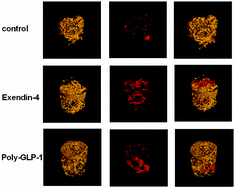Identification of a prolonged action molecular GLP-1R agonist for the treatment of femoral defects†
Abstract
Autografts are still regarded as the gold standard treatment for bone defects but they require additional surgery that causes pain for the patient. Thus, alternatives that can substitute for grafts are required. In the present study, a novel poly-GLP-1 molecule was developed using a polymeric pro-drug strategy which was found to accelerate bone healing in a mouse femoral defect model. Furthermore, the poly-GLP-1 molecule induced osteogenesis and inhibited adipogenesis in bone marrow-derived mesenchymal stem cells (BMSCs). The results demonstrate that poly-GLP-1 promoted M2 polarization of bone marrow-derived macrophages (BMDMs) and increased the levels of TGF-β1 in the bone marrow, resulting in the migration of an increased number of CD29 + Sca-1 + BMSCs to the bone surface. Finally, we found that poly-GLP-1 facilitated the migration of BMSCs due to transduction of the Smad2 signaling pathway, causing increased numbers of CD31 + Endomucin + endothelial cells in bone marrow that promoted bone formation. These results support poly-GLP-1 as a potential bone-healing agent and suggest that it may play a promising role in the clinical treatment of fracture repair.



 Please wait while we load your content...
Please wait while we load your content...